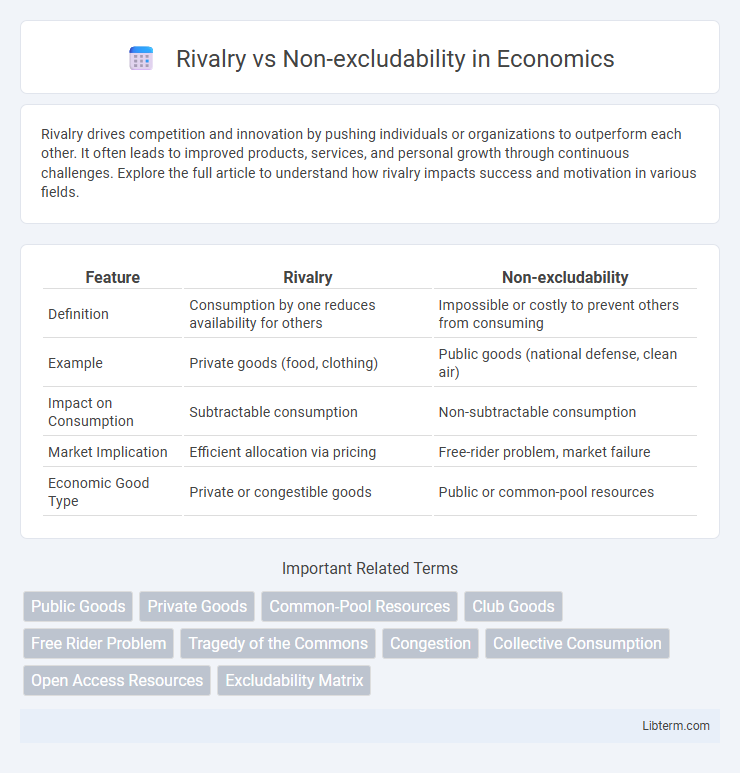Rivalry drives competition and innovation by pushing individuals or organizations to outperform each other. It often leads to improved products, services, and personal growth through continuous challenges. Explore the full article to understand how rivalry impacts success and motivation in various fields.
Table of Comparison
| Feature | Rivalry | Non-excludability |
|---|---|---|
| Definition | Consumption by one reduces availability for others | Impossible or costly to prevent others from consuming |
| Example | Private goods (food, clothing) | Public goods (national defense, clean air) |
| Impact on Consumption | Subtractable consumption | Non-subtractable consumption |
| Market Implication | Efficient allocation via pricing | Free-rider problem, market failure |
| Economic Good Type | Private or congestible goods | Public or common-pool resources |
Understanding Rivalry in Economic Goods
Rivalry in economic goods refers to the extent to which one person's consumption of a good reduces the availability for others, making the good scarce. Goods exhibiting rivalry include physical items like food and clothing, where consumption by one individual directly limits others' ability to use the same unit. Understanding rivalry is crucial for distinguishing private goods, which are both rivalrous and excludable, from public goods that are typically non-rivalrous and non-excludable.
The Concept of Non-excludability Explained
Non-excludability refers to a characteristic of goods or resources where it is impossible or highly impractical to prevent individuals from accessing or using them. This concept is central to public goods, where consumption by one person does not reduce availability to others, and preventing access is often costly or unfeasible. Understanding non-excludability helps distinguish between private goods, which are excludable and rivalrous, and public goods, which lack excludability and may or may not be rivalrous.
Key Differences: Rivalry vs Non-excludability
Rivalry refers to the consumption characteristic where one person's use of a good reduces its availability for others, such as a slice of pizza or a seat in a cinema. Non-excludability means it is impossible or costly to prevent individuals from accessing a good, as seen in public goods like national defense or street lighting. The key difference lies in rivalry affecting the quantity available for others, while non-excludability determines whether access can be restricted.
Types of Goods: Classified by Rivalry and Excludability
Goods are classified based on rivalry and excludability into four types: private goods, public goods, common resources, and club goods. Private goods are both rivalrous and excludable, meaning consumption by one person diminishes availability for others, and access can be restricted. Public goods are non-rivalrous and non-excludable, allowing multiple people to consume without reducing availability or limiting access.
Private Goods: High Rivalry and Excludability
Private goods exhibit high rivalry, meaning consumption by one individual reduces availability for others, and strong excludability, allowing owners to restrict access effectively. Examples include food, clothing, and personal electronics, where exclusive ownership and use prevent others from consuming the same unit simultaneously. This combination ensures efficient market allocation, as producers can charge prices reflecting scarcity and demand.
Public Goods: Non-rivalrous and Non-excludable
Public goods are characterized by non-rivalry and non-excludability, meaning consumption by one individual does not diminish availability for others and no one can be effectively excluded from use. Non-rivalrous goods include clean air and national defense, where multiple people benefit simultaneously without reducing the supply. Non-excludability often leads to free-rider problems, challenging efficient provision and requiring government intervention or collective action to maintain adequate supply.
Common Resources: Rivalrous but Non-excludable
Common resources are characterized by rivalry and non-excludability, meaning that one person's consumption reduces availability for others while access cannot be easily restricted. Examples include fisheries, groundwater basins, and public grazing lands, where overuse often results in the "tragedy of the commons." Effective management strategies, such as quotas or community monitoring, are essential to prevent depletion and ensure sustainable usage of these resources.
Club Goods: Excludable but Non-rivalrous
Club goods are characterized by their excludability and non-rivalrous consumption, allowing a limited group of users to access the good without diminishing its availability to others within the club. Examples include subscription-based streaming services and private parks, where access control is enforced through membership fees or permits. This combination optimizes resource allocation by preventing free-riding while maintaining shared use efficiency.
Impact on Resource Allocation and Efficiency
Rivalry in goods impacts resource allocation by limiting consumption to one user at a time, which often necessitates market-based pricing mechanisms to ensure efficient distribution. Non-excludability challenges efficient resource allocation by enabling free-rider problems, reducing incentives for private provision and leading to potential overuse or underfunding of resources. Balancing rivalry and non-excludability is crucial for optimizing economic efficiency and managing public goods effectively.
Real-World Examples Illustrating Rivalry and Non-excludability
Public parks exemplify non-excludability, allowing free access to all individuals, but they often experience rivalry as overcrowding diminishes enjoyment and available space. In contrast, private goods like smartphones demonstrate rivalry and excludability, as ownership prevents simultaneous use by others and access is restricted through purchase. Fisheries represent common-pool resources where non-excludability leads to rivalry, as overfishing by individuals reduces stock levels for the entire community.
Rivalry Infographic

 libterm.com
libterm.com